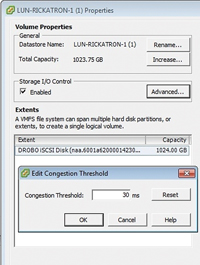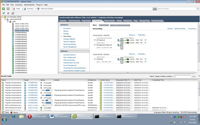Product Reviews
Review: VMware Upgrade Keeps vSphere Ahead of the Pack
An incremental update to the vSphere virtualization platform packs numerous improvements and new features to give IT professionals all the right tools.
- By Rick Vanover
- 11/01/2010
When we had indications that VMware Inc. was going to release vSphere 4.1, an update to its virtualization platform for building private clouds, there were some surprises. Primarily, the time frame: It has been hardly a year since the general availability of the 4.0 release. Secondly, the ".1" indicator was a confusing version number: At first glance, it made the release appear insignificant. (The previous product denoted the midstream update as ".5," but offered a slew of new features.) Now that it's released, it's clear that vSphere 4.1 is not a minor update -- it's a roundup of features that keep the VMware offering ahead of the competition.
Breaking Down vSphere 4.1
Here are a few configuration notes for the features that IT professionals will find most attractive:
vStorage APIs for Array Integration (VAAI): This feature set is now in its infancy but has great potential to allow enterprise storage systems to make easy work of selected vSphere I/O operations. The current list of hardware vendors that support VAAI is very short; even fewer vendors actually have products shipping with the support. What VAAI will do is give decision makers a choice to deliver a storage solution that's much more aligned to the I/O needs of the hypervisor.
Storage I/O Control (SIOC): This new feature is designed to help address the No. 1 performance issue that virtualization administrators face: slow storage. While virtualization doesn't fix underperforming storage, SIOC allows administrators to apply share-based prioritization to storage resources. Effectively Distributed Resource Scheduler (DRS) for a datastore, SIOC enforces the I/O shares across all virtual machines (VMs) that access a datastore.

[Click on image for larger view.] |
| Figure 1. The SIOC configuration screen allows a latency congestion threshold value to be set for each datastore. |
Configuring SIOC has a latency value set for each datastore. The default value is 30 ms, which is pretty generous. Finding a value that is "too slow" will vary by your requirements. Most virtualization and storage vendors gravitate toward the 20 ms value as being the transition to a problematic situation. When latency on the datastore exceeds that value, SIOC will assign disk access based on the share value of the VMs on that datastore. Like other share functions, configurations can get complicated. A generally accepted practice is to stick to the default share values of High, Normal or Low when assigning resource allocations for VMs, and avoid directly entering a share value.
SIOC is different from other DRS-like features in that it flows from the datastore to the VMs. SIOC is not based on the DRS cluster, as the datastore is a separate object. The silver lining with this is that when a datastore is configured to enable SIOC, each host that has access to that datastore is also configured.
It's also important to point out that SIOC only works for Virtual Machine File System (VMFS) volumes, which makes it one of the first features to prove my long-standing opinion that VMFS will be the first-class citizen for new features compared to Network File System (NFS)-based storage.
Network I/O Control (NIOC): Much like SIOC, the new NIOC feature allows advanced prioritization of network traffic groups that are using a vSphere vNetwork Distributed Switch. The traffic groups are Fault Tolerance VM traffic, iSCSI traffic, vMotion traffic, management traffic, NFS traffic and guest VM traffic. This categorization is important because Ethernet-based storage protocols (iSCSI and NFS) become more popular and port costs can be consolidated if the traffic patterns can be granularly managed. Network throughput is usually not one of the bottlenecks for most virtualization installations, but NIOC is one step ahead of the potential issue.
ESXi Host Authentication: Any admin will welcome a configuration to deliver a unified identity-management solution. vSphere 4.1 introduces Active Directory-integrated authentication to the ESXi hosts. This is similar to what XenServer 5.5 has been doing for a while, in that a computer account for the ESXi host is created in the Active Directory domain.
Scaling Improvements: vSphere has increased its management capacity in a number of areas. High Availability (HA) clusters, for example, are now able to scale to the same limit as a DRS cluster. Concurrent operations have also increased, including a concurrent number of vSphere Clients and concurrent provisioning operations on hosts and datastores. The most beneficial to infrastructure administrators, though, is the increase in number of concurrent vMotion operations per host. The limit is now eight current vMotion operations for 10GB networks, and four current operations for 1GB networks.

[Click on image for larger view.] |
| Figure 2. vCenter will now manage four or eight simultaneous vMotion events per host. |
Always Find Time to Course-Correct
One of the fundamental principles of virtualization that makes the lives of IT pros easier is the ability to change a configuration with ease. Whether it's a new server model functioning as host hardware, a new storage array or even the move from ESX to ESXi, vSphere makes short work of the task with minimal impact to the infrastructure for changes. The ESX versus ESXi decision is now clear, as vSphere 4.1 represents the last release of the ESX hypervisor. ESXi will be the hypervisor for subsequent versions of vSphere. While this isn't a surprise, it's not the only area of a virtualized infrastructure that may be ready for course correction. There are other features that can be rolled in with minimal interruption, such as the distributed virtual switch, which can take advantage of NIOC. IT pros should leverage the technologies to go all-in with the new features to the level at which they're licensed.
| REDMOND
RATING |
Installation:
20% |
9.0 |
Features:
20% |
10.0 |
Ease of Use:
20% |
9.0 |
Administration:
20% |
9.0 |
Documentation:
20% |
8.0 |
Overall
Rating: |
9.0 |
Key: 1: Virtually inoperable or nonexistent 5: Average, performs adequately 10: Exceptional
|
|
|
The other half of course correction for vSphere is the final push to x64 computing. A number of components of vSphere are removed from the supported configuration list with the 4.1 release. Among them is that the vCenter Server component must be installed on an x64 OS. With x64 OSes used as guest VMs, IT pros may find pressure to increase the amount of memory assigned to workloads. In many editions of Windows server OSes, the x64 releases (including Standard Edition) allow a higher memory allocation than the previous 4GB of RAM; however, the fundamental provisioning practices of memory should not be avoided.
The push to ESXi and x64 is the hidden homework behind all of these features with vSphere 4.1, but most of these changes will not be as earth-shattering as they appear. In fact, many of the elements are made easy by tools provided with vSphere. The Data Migration Tool, for example, allows a vCenter Server configuration to be moved from an x86 platform to an x64 vCenter Server with a SQL Express database running locally on the system. See VMware Knowledge Base article 1021635 for information on how to use this tool.
VMware vSphere 4.1
Price: $1,268 per processor, per year;
Enterprise Plus $4,229 per processor, per year
VMware Inc.
877-486-9273
vmware.com
About the Author
Rick Vanover (Cisco Champion, Microsoft MVP, VMware vExpert) is based in Columbus, Ohio. Vanover's experience includes systems administration and IT management, with virtualization, cloud and storage technologies being the central theme of his career recently. Follow him on Twitter @RickVanover.